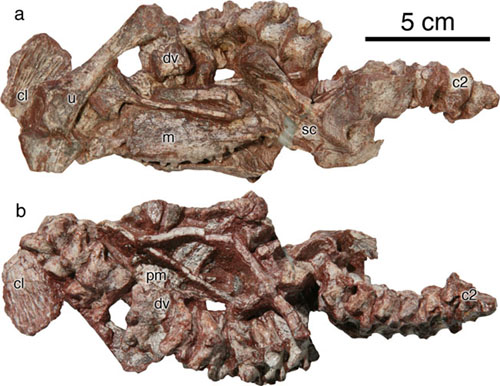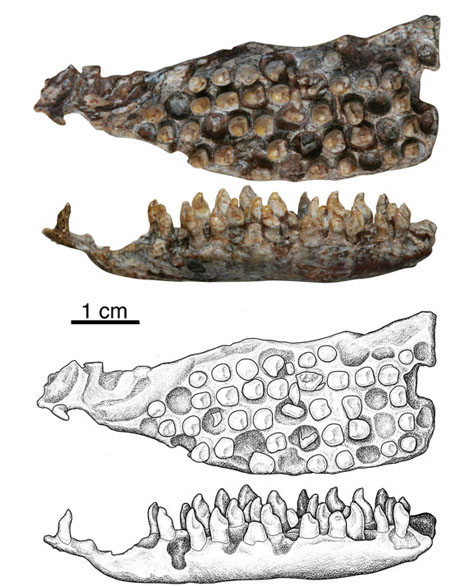| Location: Home > Research > Research Progress |
| New Captorhinid Reptile Found in China |
|
A new captorhinid reptile, Gansurhinus qingtoushanensis, gen. et sp. nov., was found from Xidagou Formation (Middle Permian) at Qingtoushan (Dashankou) locality near Yumen, Gansu Province, and from Naobaogou Formation (Late Permian) in Baotou, Nei Mongol, China, as reported in the recent issue of Naturwissenschaften 98 (435–441), 2011. The find provides new evidence for further studies on the evoluting and paleogeography of captorhinid reptiles. Captorhinids were relatively small faunivorous reptiles during their initial stages of diversification, and known only from North America and Western Europe, but by the Middle Permian they consisted of mainly medium to large omnivorous and herbivorous animals, and had spread across much of Pangea, with representative taxa present in what is now Russia, central Europe, India, Zimbabwe, Niger, Morocco, and South Africa. The earliest known captorhinids were small reptiles, up to about 30 cm in snout-vent length, and with a single tooth row on the maxilla and the dentary. However, during the late Early Permian, some captorhinids increased in size and several taxa evolved multiple tooth rows on the maxilla and mandible. New evidence suggests that the multiple tooth rowed condition evolved several times in captorhinid history, but only the moradisaurine captorhinids appear to have combined the multiple tooth rowed condition and large body size. The multiple tooth rowed condition in captorhinids can be associated with some form of dental occlusion, as evidenced by tooth wear, and indicates an omnivorous or herbivorous diet. Captorhinid material was first reported from China in 1987. The fragmentary material from the Upper Permian Naobaogou Formation of Inner Mongolia consists of partial maxillary and dentary dental plates that have been preserved in occlusion. Only the labial and lingual teeth are exposed, and the presence of multiple tooth rows can be inferred from the roots of teeth that have been exposed by erosion on the dorsal surface of the maxilla and the ventral surface of the dentary. The fragmentary nature of this material and the unusual morphology of the dentition made identification of this specimen tentative, and this report was largely ignored by subsequent workers. The reported new captorhinid reptile, Gansurhinus qingtoushanensis, is a medium-sized moradisaurine captorhinid characterized by the presence of a long diastema between the single anterior tooth and the multiple tooth-rowed region of the upper dentition. It differs from other moradisaurines in having a maximum of five tooth rows on the maxillary and dentary dental plates, with individual teeth bearing a cusp-like emargination on the posterior aspect of the crown. Captorhinids were a diverse group of basal early reptiles, which ranged from the Late Carboniferous into the latest Permian, corresponding to a temporal range of more than 50 million years making them the longest lived clade of reptiles confined to the Paleozoic. “The discovery of well-preserved captorhinidmaterials in theMiddle Permian of China allows us to determine that the new taxon, Gansurhinus qingtoushanensis, gen. et sp. nov, is a member of Moradisaurinae, a clade of captorhinids with multiple tooth rows arranged in parallel”, said said Dr. Robert R. Reisz, lead author, professor of Department of Biology, University of Toronto Mississauga, “The presence of this moradisaurine in the Middle Permian of south central Asia leads us to suggest that paleogeographic changes during the Permian, with part of what is today China becoming a large peninsula of Pangea, allowed these early reptiles as well as other terrestrial vertebrates to extend their geographic ranges to this region of the Late Paleozoic supercontinent.” “Their evolutionary history is particularly interesting and important because they represent the first pulse of reptilian diversification and geographic dispersal in terrestrial vertebrate evolution, but one that appears to have terminated by the Permo–Triassic boundary”, said Dr. LIU Jun, co-author, Institute of Vertebrate Plaeontology and Paleoanthropology, Chinese Academy of Sciences. “The presence of the new fossil material provides paleontological confirmation of the proposed connection between China and Pangea towards the end of the Paleozoic. In contrast to bolosaurids, whose paleogeographic distribution in the Paleozoic is restricted to the equatorial and subequatorial regions of Pangea, captorhinids have a much wider distribution. Members of the clade are present in higher northern latitudes of Laurasia, in central and southern Africa, and in India. Their presence in China expands their geographic range, raising the possibility that they are the first eureptiles to have gained a near global distribution”, said Dr. Johannes Müller, co-author, Museum für Naturkunde, Leibniz-Institut für Evolutions- und Biodiversitätsforschung an der Humboldt-Universität zu Berlin.
Fig.1: Holotype of Gansurhinus qingtoushanensis gen. et sp. nov. (IVPP V15989) (Image by Robert R. Reisz)
Fig.2: Photographs and illustrations of left maxilla of Gansurhinus qingtoushanensis gen. et sp. nov. in ventral and medial |

